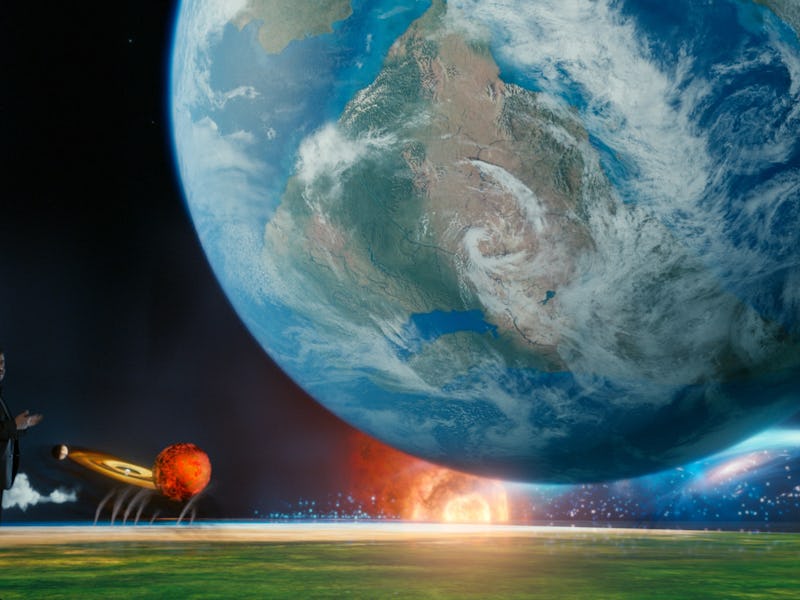Why Alien Life on "Triassic Worlds" Might be Easiest to Spot
Highly oxygenated worlds like Earth during the Age of Dinosaurs might be prime targets for astrobiology.

If we want to look for signs of life on other worlds, we might want to look to our planet’s past, specifically when dinosaurs roamed the Earth.
A recent study suggests that when searching the chasm of light years between Earth and other possibly habitable planets, biosignatures present during Earth’s Paleozoic and Mesozoic eras would be much easier to detect. This is in large part due to this era’s oxygen-rich atmosphere compared to modern Earth. Cornell University astronomers Lisa Kaltenegger and Rebecca Payne published their work in the Monthly Notices of the Royal Astronomical Society.
Neil deGrasse Tyson demonstrates what Earth might have looked like around 300,000 years ago.
In Search of Triassic Worlds
Kaltenegger and Payne used climate models and geological evidence to figure out how much oxygen and other gases Earth’s atmosphere would have contained at important milestones in the planet’s past 500 million years, a geologic eon known as the Phanerozoic (of which we are still living). Next, they simulated how those ancient atmospheres might have looked to astronomers on distant worlds by watching as Earth passed in front of the Sun.
Human astronomers today use the same method to measure the atmospheres of planets around other stars: as a planet passes between Earth and its star, the planet’s rocky bulk blocks the star’s light, but some light filters through the thin sliver of atmosphere around the edges of the planet. By measuring the spectrum of that filtered light, astronomers can see a sort of chemical fingerprint of the different gases that make up the atmosphere. This cool science trick works because chemical compound absorbs and reflects light at different wavelengths.
Our ability to spot any particular gas in a planet’s atmosphere depends mostly on how much of a particular gas is present. For instance, around the time the first dinosaurs started walking around, Earth’s oxygen level was just coming down from an all-time high; Kaltenegger and Payne estimate oxygen made up 30 to 35 percent of the planet’s atmosphere.
“And so to distant observers, that might have looked like an even more advanced or life-rich planet, just because there was so much oxygen in the atmosphere,” Payne told Inverse.
A Chemical Fingerprint of Life?
Oxygen by itself isn’t proof that a planet is teeming with alien life — or even that it’s habitable but vacant. But an oxygen-rich atmosphere does mean that a planet is probably worth a closer look.
"Figuring out how habitable places are is kind of a numbers game," says Payne, "looking at how strong the signals are, but then also what signals are there, and in what combination."
One of those combinations could be oxygen and methane. Both chemicals are produced by living things, geological processes, and chemical reactions in the upper atmosphere. The catch is that methane and oxygen don’t like to coexist for very long, as Payne puts it. In Earth’s upper atmosphere, ultraviolet radiation from the Sun powers chemical reactions that mix methane and oxygen to create carbon dioxide and hydrogen.
So if astronomers see stable amounts of both gases floating around in a planet’s atmosphere, it probably means that something on the surface is constantly replenishing them — and that something might be living, breathing beings.
“I think, generally, most astrobiologists would consider a compelling case to be abundant oxygen and ozone, and at least a sustained but smaller amount of methane,” says Payne. “Seeing the combination of those biosignature gases plus a climate that makes things habitable, evidence of water: those are all pretty compelling points for saying, ‘that's a place that's really worth looking at.’ But until we have direct imaging, it's hard to say definitively [life] is there, for sure.”
200 million years ago, the Pangean supercontinent was just beginning to split up; Earth hasn’t always been our version of Earth.
One Planet, Many Worlds
Payne says the point of this study isn’t just that planets like ancient Earth might be easier to recognize as habitable candidates. Understanding Earth’s earlier phases — and mapping how atmospheric spectra are related to temperature and geological activity on the surface — could help astronomers interpret the spectra they see from distant worlds.
If you know how those things shape a planet's atmospheric makeup, then looking at the spectrum of light filtering through an alien atmosphere can give you a general sense of what that distant world might be like (at least in terms of things like geology and surface temperature). And if a far-off planet’s atmosphere looks a lot like Earth’s Triassic atmosphere, “then that's an indicator that it makes a compelling case that that's potentially what it's like,” says Payne.
When astrobiologists are pondering the habitability of alien worlds, Earth is the only example for comparison. But our planet has been through a lot of changes since it formed 4.6 billion years ago, and records of most of those changes are still preserved in rock layers. For the last 2 billion of those years, our biosphere would have been visible to distant alien astronomers with their own versions of the James Webb Space Telescope.
“Earth today isn't the same as Earth 500 million years ago, or 2 billion years ago, or 4 billion years ago,” says Payne. “It's such a varied history that Earth becomes a really good reference point; even though it's just the one data point, we can kind of make it into more than just one reference for looking for life elsewhere.”
In other words, our planet only provides a sample size of one, but that sample contains multitudes.